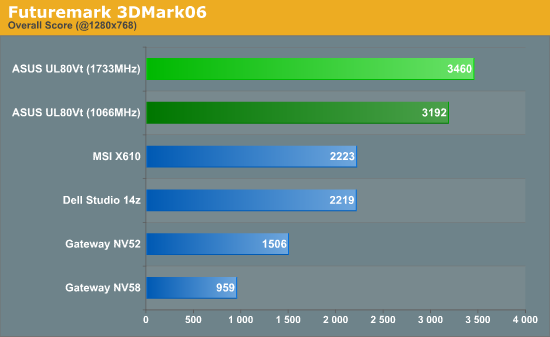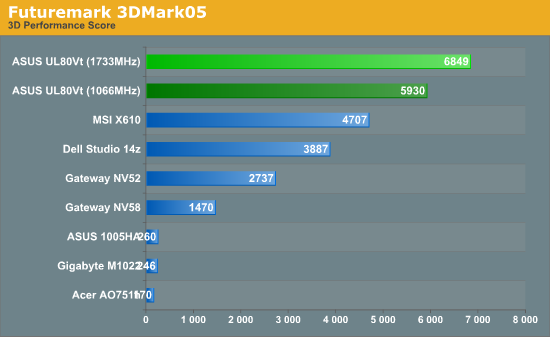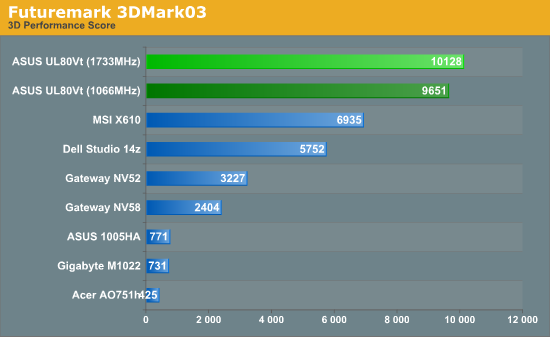ASUS UL80Vt First Look: Mobility Redefined
by Jarred Walton on October 24, 2009 8:00 PM EST- Posted in
- Laptops
ASUS UL80Vt Benchmarked - Graphics Performance
Our testing for now is confined to the use of the discrete GeForce G210M graphics on the UL80Vt. When we deliver our full review, we will include additional results using the integrated GMA 4500MHD. You can get a good idea of the 4500 MHD performance by looking at the Gateway NV58 results; the NV58 has a faster CPU, but for 3DMark and gaming performance the GPU is going to be a huge bottleneck.




Looking at 3DMark graphics performance, the G210M combined with the overclocked SU7300 delivers respectable performance. The G210M is clearly faster than the 9400M G integrated solution, with the advantage ranging from a low of 30% in 3DMark Vantage up to a high of 76% in 3DMark03. We realize 3DMark isn't true gaming performance, but most games correlate well with one of the versions. 3DMark06 and Vantage include CPU performance into the final score, which is why the gap between the 14z and UL80Vt isn't quite as large -- the P8600 should be at least 39% faster than the overclocked SU7300, and the detailed results confirm that. The CPU score in 3DMark06 is 1571 for the UL80 compared to 2117 with the 14z (a 35% advantage to the 14z), while the CPU score in Vantage is 3344 vs. 4284 for the 14z (28% faster). Meanwhile the 3D scores favor the UL80 by 58% in Vantage and 69% in 3DMark06. For reference, the Gateway NV52 with HD 3200 isn't even close in 3DMark; the UL80Vt is 130% to 214% faster!
Even at 1066MHz, the SU7300 with the G210M puts up a fight. The lead drops to 7.5% in Vantage (due primarily to the low CPU score), but it's still 44% in 06, 53% in 05, and 68% in 03. The comparison to the NV52 continues to be a landslide in favor of the SU7300+G210M: it's 105% faster in Vantage and up to 200% faster in 3DMark03.
We recognize that 3DMark isn't the be-all, end-all indicator of gaming performance, but as a quick test we can see that UL80Vt with the G210M enabled should never be slower than laptops with integrated graphics when it comes to gaming (i.e. the Dell 14z with 9400M G and the Gateway NV52 with HD 3200). It's also worth noting that the UL80Vt supports NVIDIA's reference drivers, just like other laptops with GeForce graphics (although you'll need to wait for updated drivers from NVIDIA if you want something newer than the 186.88 drivers the laptop ships with). At present, for graphics in notebooks the pecking order is roughly as follows:
- High-end and midrange discrete solutions (GeForce GTX 280M/260M and Mobility Radeon HD 4670 and 4870)
- Lower end discrete solution (Radeon HD 4330 and HD 3670, or GeForce 210M and 9600M, etc.)
- NVIDIA's current integrated graphics (GeForce 9400M G -- represented by the Dell Studio 14z).
- ATI's current integrated graphics (Radeon HD 3200 -- i.e. the Gateway NV52).
- Intel GMA 4500MHD and older NVIDIA/ATI IGP solutions (X1260 or GeForce 7000 or earlier).
- Intel's GMA 950 and earlier (typically seen in netbooks now).
The corollary to the above is pricing and power, and generally speaking the higher you go on the list, the more expensive the parts become and the worse battery life you get. That's the great benefit of designs like the UL80Vt: you can get reasonable graphics performance when you need/want it, but you can still switch off the graphics and run on the IGP for improved battery life. The G210M is designed to use a maximum of 8W, but when the rest of the laptop averages less than 10W of power, that's a potential 80% increase in power requirements. The slower IGP solutions -- especially from Intel -- do manage to keep power requirements low while offering dismal gaming performance. The HD 3200 and 9400M are much more palatable in terms of overall performance and video offloading features, with power requirements that are about the same as the GMA 4500.










100 Comments
View All Comments
gohilurvish - Sunday, October 25, 2009 - link
I like the article and also the battery life figure by particular Asus model but I dont agree to compare it with MacBook (I am not Apple fan-boy).From what I know is, all 9400M based MacBook/pro has C2D Penryn processors and with <55WHr battery it provides 6-7Hrs of battery life with wireless productivity.
If these lineup moves to ULV processor and 80+WHr I am sure it can deliver 15+hrs or battery life.
I think its OS and other hardware that helps giving longer battery life for MacBook.
For winodows PC, this is my choice now (obviously not for computational heavy work).
fk49 - Sunday, October 25, 2009 - link
This is a great first look and much more in depth than most of the previews that come out. I did notice that the main CPU comparison was with the P8600 of the 14z which is definitely meant for a higher price point. For the full review, could you include benchmarks comparing the SU7300 to more CPUs? Especially in the gaming benchmarks, as the G210m will definitively beat the integrated solutions available but what's not clear is how CPU-limited games might be when the UL80vt competes against laptops with dedicated GPUs. Thanks and again, great review!darwinosx - Sunday, October 25, 2009 - link
Since everything is compared to the Mac laptops that is obviously the gold standard. That should tell you something. For a minor amount more you get a dramatically better laptop build, screen, cpu, multi-touch trackpad, and of course OS. Not to mention support. Put one of these next to a MacBook at your local Fry's or wherever. The Mac Book walks all over it. Yes Windows 7 is decent. But I want a lot more than decent when it comes to my notebook or desktop computers. I make quite a good living as an IT Architect and I don't have time or interest in buying the lowest common denominator to save a little money.simas - Monday, October 26, 2009 - link
Mac Book /OSX = No games.and buying overpriced laptop label just to by Microsoft OS to be able to play a game is too wasteful. There isn't anything OSX delivers in the laptop that I can not get from Windows 7 so why pay the premium?
for Asus - they are close, dual core CPU, switchable graphics, 4+ GB of ram, decent CPU speed and good battery life. Get a better LCD and I would buy it.
Kelv00n - Sunday, October 25, 2009 - link
Quoting: "I make quite a good living as an IT Architect and I don't have time or interest in buying the lowest common denominator to save a little money."1) You're clearly an Apple fanboi; ergo anything not Apple is the lowest common denominator; ergo your comments add nothing to a proper evaluation of this machine and are therefore useless to other readers who are not facetious like you.
2) No one cares about how big your wallet (and what it compensates for) is, and as many commentators here have observed, this laptop fills a nice role for people like non-trust fund college kids who have to a) consider weight and performance since they have to lug the piece around, and b) work to pay their own way through college.
Asus has been making lots of right moves lately. They just need to ditch the glossy trend and work on their build quality. This laptop is hitting the sweet spot for the holy trinity of weight, performance and price. I'm going to wait for the next iteration, which hopefully will have a better LCD, but it looks like my new laptop will be ASUS-branded.
fk49 - Sunday, October 25, 2009 - link
Even so, comparisons to Mac performance is something some of us would like to see. The Macbook does cross the $1000 line and as a student, the price difference with the UL80 is meaningful. About half the kids at my school have Macs while Asus has a pretty niche market, so it would be interesting to see if an aggressively designed and priced product aimed at the tech-savvy can beat the mainstream "standard".Voo - Sunday, October 25, 2009 - link
Well I won't be using Mac OS X any time soon and I don't think many Apple fans would even consider it.So the interesting comparision would be a MacBook with Win7 against this one.
Voo - Sunday, October 25, 2009 - link
Argh.."and I don't think many Apple fans would even consider using this notebook."
MournSanity - Sunday, October 25, 2009 - link
If I may make a feature request for the full review...I heard that this laptop can also be overclocked from the BIOS. Can you look into this feature and tell us how/if it works in conjunction with the Turbo33 setting? Thanks.
MournSanity - Sunday, October 25, 2009 - link
I ask this because I recall seeing on a taiwanese review of this laptop a picture of it overclocked to something like 2133 mhz(8x266?). It would be very cool if this machine can be stably overclocked that high for when you want to do some heavy lifting.